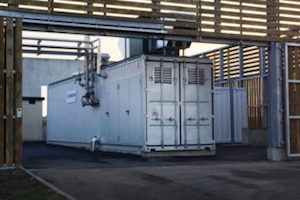14 works of Lecornu to release anaerobic digestion in France
Aurélie Barbaux Factory New the 26 / 03 / 2018
The working group on the liberation of the methanisation made its conclusions. He advocates 14 actions to help farmers supplement their income, professionalize the anaerobic digestion system and accelerate projects. 
No secret, to reach the goal of 10% renewable gas in 2030 consumption by 2015 energy transition law, France needs its farmers. It is in fact anaerobic digestion, the production of biogas after fermentation of agricultural waste, which is the best way today to produce renewable gas in France. Other technologies, such as gasification or power-to-gas are still in development. But today France produces less than 1% of the gas it consumes. As for the end wind 2017, the group has therefore launched in January 2018 workshops to release methanation. It was expected the conclusions for the Agricultural Fair, but the Secretary of State for ecological transition and solidarity, Sebastien Lecronu, did not reveal the result that Monday 26 March. The working group recommends 14 actions to help farmers to supplement their income, professionalize the anaerobic digestion system and accelerate projects while developing a French sector.
1 - Launch a call for tenders for atypical projects.The idea is to integrate methanization projects with injection that do not fit into the specifications of existing tenders, which currently focus exclusively on the installation of methanisers. These projects will increase the production of biogas at existing sites.
2 - Create a non-tender feed-in tariff for small installationsThe state will simplify the tariff support rules with the creation of an open-face feed-in tariff for medium-sized 500 kW installations at 1 MW rather than bidding too heavy for this size of project. This measure will be taken by order.
3 - 100 BPI guarantee fund millions of eurosTo facilitate access to credit for farmers with an anaerobic digestion project, the Minister of Agriculture has announced that he will devote 100 million euros to the Large Investment Plan (GPI) to fund a BPI guarantee fund. for the benefit of agricultural biogas projects.
4 - No longer consider digestate wasteTo facilitate the organic recovery of digestates (residues of anaerobic digestion that can be used as fertilizer) and secure farmers' supplies, an adapted standard dedicated to digestates will be developed with the profession, as one already exists on composts.
5 - Allow the use of bioGNV by agricultural machineryThe use of bioGNV by agricultural machinery will be made possible on the national territory following a work in progress at European level on the amendments to Regulation 167 / 2013 on the approval of agricultural vehicles and its delegated acts ( 2015 / 96 and 2015 / 504 regulations).
6 - Financing methanizers supplying CNG stationsFinancial support will be put in place for the methanisers that supply the vehicles (buses, trucks) to develop a new direct local use of biomethane, particularly in remote areas of the gas network.
7 - Training in good practices Training will be set up for all stakeholders, with a steering of the Ministry of Agriculture as regards training for the agricultural world. This training plan will help project leaders to present plans limiting nuisances and promoting local dialogue.
8 - Push the die for certificationThe structuring of the sector must allow each actor in the value chain (investors, project leaders, engineering firms, equipment manufacturers, operators) to adapt to the French multi-input context and to fit into an economic model. sustainable. One of the keys to this structuring is the initiation of a quality approach (guides, charters, labels, certification, standards, etc.) to promote efficient project development, reassure investors and reduce costs. of production.
9 - Simplifying the regulation of classified installations (ICPE)The State will reduce the processing time from 1 year to 6 months and increase the threshold applicable to the ICPE declaration (100 tonnes / day against 60 tonnes / day). This registration regime, which is more flexible, will be extended to all the ICPE biogas activity, in addition to the possible reporting regime for agricultural methanation.
10 - Create a one-stop shop for regulatory recordsEach prefect will designate a “one-stop-shop” state service to receive the various regulatory files relating to methanizers (ICPE / IOTA or health approval file).
11 - Simplifying the regulation "water law"Methanizers subject to registration or ICPE declaration will henceforth be subject to the "registration" regime, which will result in the elimination of the impact study and the public inquiry.
12 - Allow Mixtures of InputsMoving to a larger scale involves developing large-scale methanisers and diversifying the deposits to be methanised (waste from the agro-food industries, biowaste, landfill biogas, sludge from wastewater treatment plants). The government expects a gradual decline in production costs (100 80 euros / MWh) and the development of a French and European biogas equipment.
Mixtures of inputs will therefore become possible, but only under enhanced safety conditions for agricultural land in the case of digestate application. By default, the blend will apply the strictest spreading rules to its components and a general traceability rule will be defined.
13 - Generalize the anaerobic digestion of sludge from major wastewater treatment plantsOnly 22% of sewage sludge is methanised. To generalize it, a work with the communities and the professionals starts to specify the calendar and the supports. Anaerobic digestion significantly reduces sludge volumes and also facilitates other uses than spreading.
14 - Create a "right to injection"The working group proposes the creation of a "right to injection" in the natural gas networks as soon as the anaerobic digestion installation is located near an existing network to prevent projects from being blocked due to lack of capabilities. Network managers will be responsible for making the necessary investments to make this possible.






